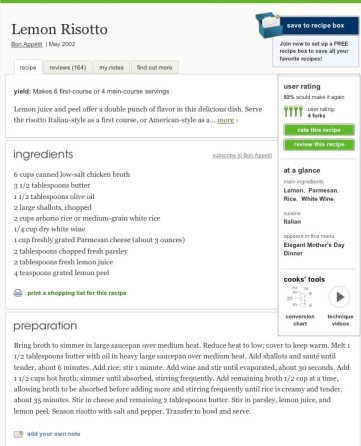Here is a recipe for Lemon Risotto from http://www.epicurious.com:

We know this is a recipe, and not say a research report, partly through the field of discourse.
Within the context of situation, field refers to:
what is happening, to the nature of the social action that is taking place: what is it that the participants are engaged in, in which language features as some essential component?
(Halliday & Hasan, 1985, p.12)
We can divide field into three areas:
1. experiential domain, or what the text is about. In the case of a recipe, it is about food and food preparation.
2. goal orientation, or what the text is for in terms of both short-term and long-term goals. The short-term goal is obviously to make the recipe but the long-term goal is, I think, a little more complicated. Why are we making this dish? For example, as some research shows, there are cultural differences between Japanese and English that affect the long-term goals of food preparation. In Japan, cooking is, to a large degree, a serious matter and the goal is to reproduce the recipe exactly as shown, as opposed to the life-style/aspirational aspect of more Western cooking. I think also there are differences in the idea of the home as a private space, as in Japan, or a more public space for entertaining, as in English. This in turn affects the last area:
3. social activity, or what the text is doing. The activity of cooking in Japan is essentially a private or family activity. There is no real equivalent of the English-speaking or European idea of entertaining in your home or the dinner party. You can see this difference most clearly when looking at portion sizes. Googling ‘lemon risotto recipe’ or ‘レモン リゾット レシピ’ brings up recipes that in English, such as the one above, nearly always serve 4-6, or more, whereas the Japanese ones are for 1-2 people.
These three areas together make up the field of discourse, which is expressed through the experiential metafunction: there are specialised lexical items, such as broth, arborio and peel as well as material Processes, like simmer and stir. To a large degree, I think we also know that the above is a recipe (and the field of discourse is recognised by) external features such as lay-out, pictures, and the fact it says ‘recipe’.
Although I think there is a lot more to it and Hasan, in particular, has gone much further into the system of field in more detail, for the purposes of EFL I’ve found discussing just these three to be useful.
